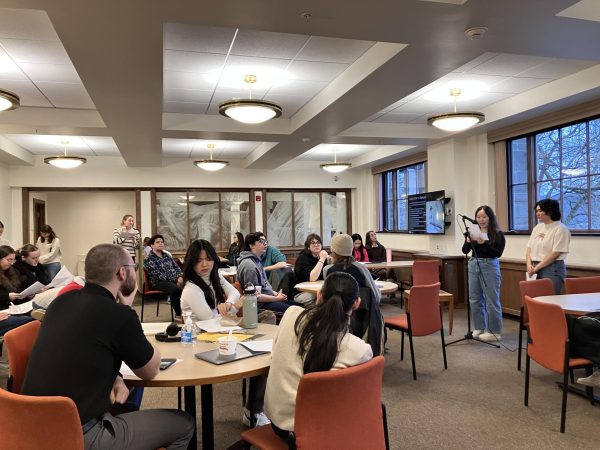Native American Arts and Culture Festival
While many students would not consider participating in a traditional Native American “snake dance” alongside colorfully adorned members of indigenous communities a typical way to spend their Saturday afternoon, this year’s annual Native American Arts and Culture Festival provided exactly that opportunity. Organized by Director of the Native American Studies Program and Associate Professor of Native American Studies Carol Ann Lorenz, the free fair took place from 9:30 a.m. to 5 p.m. on Saturday, October 21 in the Sanford Field House.
For the past fifteen years the Native American Studies program, with cooperation from Native American Student Allies, has organized the fair to expose eager attendees to the culture and traditions of indigenous peoples from North, Central and South America as well as members of the Haudenosaunee Nation, otherwise known as the Iroquois. This year, support from the Upstate Institute, Core Communities and Identities, Sociology and Anthropology Department, ALANA Cultural Center and the Longyear Museum of Anthropology helped pull the fair together.
Throughout the day, a variety of traditional music and dance performances occurred on stage including a traditional flute music performance and an interactive display of social Iroquois dances that involved bolder members of the audience. Meanwhile throughout the building, vendors displayed and sold everything from native lacrosse sticks to beaded jewelry, tan hides, weaponry and native medicines.
In the crowd, students, professors, members of the Hamilton community and children enjoyed the various displays and activities. The inclusive nature of the fair included a section for children’s activities that offered the opportunity to create a beaded bracelet or decorate cloth pouches and paper canoes. Starting at 12:15 p.m., pottery, basket weaving, silver working and stone carving demonstrations drew in crowds of all ages as well.
The entirety of attendees also enjoyed Hamilton Eatery’s new role as the “Iroquois Eatery,” which offered buffalo burgers, venison and elk sausage, Indian tacos, corn soup, taco salad and buffalo chilli among others relevant items.
Before the various performances, which included flutist Dan Hill, Haudenosaunee Singers and Dancers, folk music and dance group Tahuantinsuyo, singer Darryl Tonemah and Bolivian ensemble Música de Maestros, explanations were often given explaining the cultural significance of the display. For instance, giving thanks for everything available in natural surroundings was stressed as a significant part of native life before a chicken dance ensued.
Senior Sabrina Farmer heard about the event through a professor who works with the Bolivian group that performed.
“I am always into coming to these fairs where they have a lot of crafts. They’re native crafts and they’re obviously for sale, but I don’t know if I’m meant to wear them because often it feels like cultural appropriation if they’re something native. I’ve had a couple of interesting conversations with women at the booths about it,” Farmer said.
Several vendors spoke on the issue and essentially pointed out that items such as tan hides have been sold as leather for generations in every different culture, so the items can belong to attendees, too.
“I feel like people can learn a lot from talking to people here. When people come and look at the stuff without talking to anyone, it’s a loss of what they could learn,” Farmer added.
Mohawk Alicia Cook has been attending the event since its founding fifteen years ago. Cook enjoys sharing her family’s medicines and the manner in which they harvest plants and perform rituals with the 1,000 to 1,500 attendees that stroll through the fair throughout the day.
“It’s sort of dying so it’s always good to share the culture,” she said. Her table displayed beaded jewelry, antlers, medicines, bones and wood carvings.
The event came together largely through the efforts of the Native American Student Association (NASA), which funds several of the performances. Two of the three Native American majors on campus, junior Ronald Cupitt and senior Sierra Sunshine, helped run a booth by the door to provide information to visitors. After all of the officers of the organization graduated last year, they were glad the new leadership successfully ran this year’s event.
“It’s gone really well. The past couple of years it’s been really rainy and cold. It’s kind of nice that people are coming in not cold and miserable,’ Sunshine said.
Ultimately, with the Iroquois originating in upstate New York, an event that highlighted the distinct culture of Native American peoples from several continents and endless states proved incredibly relevant and worthwhile to the Colgate community.
Contact Lauren Hutton at [email protected]
Lauren Hutton is a senior from Pembroke Pines, Florida double concentrating in Women’s Studies and English with a creative writing emphasis. She has...






